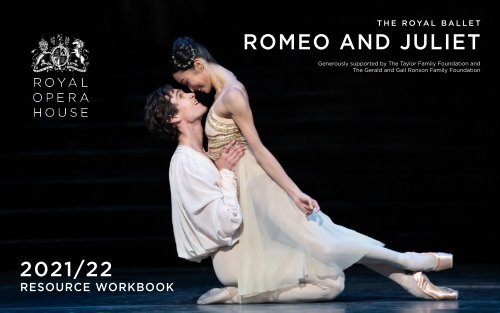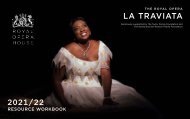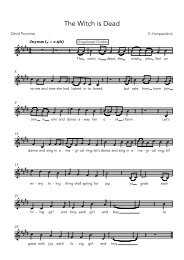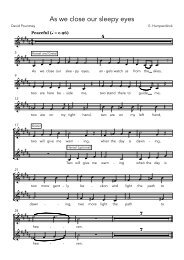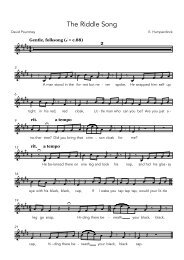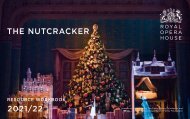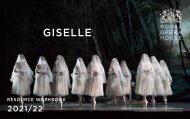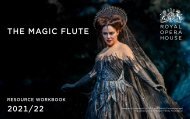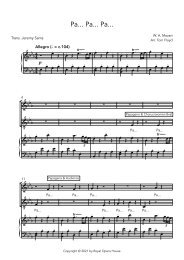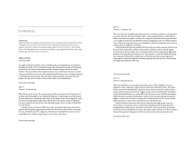Romeo and Juliet digital resource book
You also want an ePaper? Increase the reach of your titles
YUMPU automatically turns print PDFs into web optimized ePapers that Google loves.
THE ROYAL BALLET<br />
ROMEO AND JULIET<br />
Generously supported by The Taylor Family Foundation <strong>and</strong><br />
The Gerald <strong>and</strong> Gail Ronson Family Foundation<br />
2021/22<br />
RESOURCE WORKBOOK
YOUR VISIT<br />
We are really excited to welcome you <strong>and</strong><br />
your students to the Royal Opera House for<br />
the Schools’ Matinee of <strong>Romeo</strong> <strong>and</strong> <strong>Juliet</strong> on<br />
Thursday 24 February 2022.<br />
Welcome to the Royal Opera House film<br />
This film introduces you <strong>and</strong> your students to the Royal<br />
Opera House, guiding them through the spaces they will visit,<br />
introducing them to some of the people they will encounter <strong>and</strong><br />
some of the exciting things they might see.<br />
Cover, William Bracewell as <strong>Romeo</strong> <strong>and</strong> Fumi Kaneko as <strong>Juliet</strong> in <strong>Romeo</strong> <strong>and</strong> <strong>Juliet</strong> ©2021<br />
ROH. Photographed by Bill Cooper. Left, Steven McRae as <strong>Romeo</strong> <strong>and</strong> Sarah Lamb as <strong>Juliet</strong> in<br />
<strong>Romeo</strong> <strong>and</strong> <strong>Juliet</strong> ©2015 ROH. Photographed by Alice Pennefather
THE STORY<br />
<strong>Romeo</strong> <strong>and</strong> <strong>Juliet</strong> – a story of ‘star-crossed lovers’ – is part<br />
of a tradition of stories that date back to ancient Greece,<br />
through Italian poetry, <strong>and</strong> was most famously told by William<br />
Shakespeare. Since Shakespeare, this story has been retold<br />
many times – including in Kenneth MacMillan’s ballet, which<br />
follows Shakespeare’s play very closely.<br />
ACT I<br />
Two noble families live in Verona: the Capulets <strong>and</strong> the<br />
Montagues. They are sworn enemies <strong>and</strong> have been feuding for<br />
many years. A fight breaks out in the town square. The Prince<br />
of Verona stops it <strong>and</strong> comm<strong>and</strong>s the families to end their<br />
feud. <strong>Juliet</strong> is playing with her nurse when she is interrupted<br />
by her parents, Lord <strong>and</strong> Lady Capulet. They introduce her<br />
to Paris, a rich young man who wants to marry her. Guests<br />
arrive for a ball at the Capulets’ house. <strong>Romeo</strong> <strong>and</strong> his friends<br />
Mercutio <strong>and</strong> Benvolio wear masks to disguise themselves<br />
<strong>and</strong> try to catch the attention of Rosaline. Once inside the<br />
party, however, <strong>Romeo</strong> becomes much more interested in<br />
<strong>Juliet</strong> ,who he sees across the room. They dance together <strong>and</strong><br />
sparks fly between them. Mercutio tries to distract <strong>Romeo</strong>,<br />
while <strong>Juliet</strong>’s cousin Tybalt tries to follow him, but is stopped<br />
by Lord Capulet. After the party <strong>Juliet</strong> is unable to sleep <strong>and</strong><br />
comes out onto her balcony. Just as she thinks of him, <strong>Romeo</strong><br />
appears in the garden <strong>and</strong> they tell each other they are in love.<br />
ACT II<br />
<strong>Romeo</strong> watches a wedding procession <strong>and</strong> dreams of marrying<br />
<strong>Juliet</strong>. Her nurse brings him a letter from <strong>Juliet</strong> saying she<br />
wants to marry him immediately. <strong>Romeo</strong> <strong>and</strong> <strong>Juliet</strong> are secretly<br />
married by Friar Laurence, who hopes that this union will end<br />
the feud between the Montagues <strong>and</strong> the Capulets. Back in the<br />
town square Tybalt fights with Mercutio <strong>and</strong> kills him. <strong>Romeo</strong> is<br />
devastated at the death of his friend <strong>and</strong> fights <strong>and</strong> kills Tybalt.<br />
ACT III<br />
<strong>Romeo</strong> <strong>and</strong> <strong>Juliet</strong> spend the night together before <strong>Romeo</strong><br />
must flee Verona at dawn. <strong>Juliet</strong>’s parents arrive with Paris<br />
<strong>and</strong> <strong>Juliet</strong> refuses to marry him. Hurt, Paris leaves, <strong>and</strong> <strong>Juliet</strong>’s<br />
angry parents threaten to disown her. <strong>Juliet</strong> rushes to see<br />
Friar Laurence <strong>and</strong> begs him for help. He gives her a potion<br />
that will make her fall into a very deep sleep – so deep she<br />
will appear to be dead. <strong>Romeo</strong> is sent a message by Friar<br />
Laurence, explaining their plan. Back in her bedroom, <strong>Juliet</strong><br />
agrees to marry Paris, but then takes the potion <strong>and</strong> collapses.<br />
Her friends <strong>and</strong> family find her apparently dead, <strong>and</strong> she is laid<br />
to rest in the family crypt. <strong>Romeo</strong> has returned from exile <strong>and</strong><br />
hides himself until everyone but Paris leaves. Believing <strong>Juliet</strong> to<br />
be dead, <strong>Romeo</strong> stabs Paris <strong>and</strong> mourns <strong>Juliet</strong>, taking his own<br />
life by drinking poison. <strong>Juliet</strong> awakes to find <strong>Romeo</strong>’s body.<br />
Devastated, she stabs herself <strong>and</strong> dies reaching out to him.
THE CHARACTERS<br />
ROMEO<br />
JULIET<br />
MERCUTIO<br />
TYBALT<br />
A young man from the Montague<br />
A young woman from the Capulet<br />
A Montague, <strong>Romeo</strong>’s closest<br />
A Capulet, <strong>Juliet</strong>’s cousin is an<br />
family who is in love with Rosaline,<br />
family who seems destined to<br />
friend, Mercutio is a dreamer <strong>and</strong> a<br />
angry young man, eager to defend<br />
until he meets <strong>Juliet</strong>.<br />
marry Paris, a young nobleman.<br />
romantic.<br />
his family’s honour <strong>and</strong> fight the<br />
Montagues.<br />
Marcelino Sambé as <strong>Romeo</strong> in <strong>Romeo</strong> <strong>and</strong> <strong>Juliet</strong> ©2019 ROH. Photographed by Helen Maybanks.<br />
Fumi Kaneko as <strong>Juliet</strong> in <strong>Romeo</strong> <strong>and</strong> <strong>Juliet</strong> ©2021 ROH. Photographed by Bill Cooper.<br />
Luca Acri as Mercutio in <strong>Romeo</strong> <strong>and</strong> <strong>Juliet</strong> ©2021 ROH. Photographed by Bill Cooper.<br />
Ryoichi Hirano as Tybalt in <strong>Romeo</strong> <strong>and</strong> <strong>Juliet</strong> ©2021 ROH. Photographed by Bill Cooper.
THE CHARACTERS<br />
BENVOLIO<br />
Another Montague friend of<br />
<strong>Romeo</strong> <strong>and</strong> Mercutio.<br />
THE NURSE<br />
<strong>Juliet</strong>’s nurse has known her since<br />
she was born. She knows <strong>Juliet</strong><br />
better than her parents, <strong>and</strong><br />
becomes a trusted messenger <strong>and</strong><br />
go-between.<br />
LORD AND LADY<br />
CAPULET<br />
<strong>Juliet</strong>’s protective parents who<br />
want to see their daughter happily<br />
married to a good match – not to a<br />
Montague!<br />
THE PRINCE OF<br />
VERONA<br />
The ruler of the city state in which<br />
the story is set. Neither a Capulet<br />
nor a Montague, the Prince is<br />
weary of the feud between the<br />
two families.<br />
Tristan Dyer as Benvolio in <strong>Romeo</strong> <strong>and</strong> <strong>Juliet</strong> ©ROH/Johan Persson, 2013.<br />
Mica Bradbury as the Nurse in <strong>Romeo</strong> <strong>and</strong> <strong>Juliet</strong> ©2021 ROH. Photographed by Bill Cooper.<br />
Christopher Saunders as Lord Capulet <strong>and</strong> Christina Arestis as Lady Capulet in <strong>Romeo</strong><br />
<strong>and</strong> <strong>Juliet</strong> ©2019 ROH. Photographed by Helen Maybanks.<br />
Thomas Whitehead as Prince of Verona in <strong>Romeo</strong> <strong>and</strong> <strong>Juliet</strong> ©ROH/Johan Persson, 2010.
CONTENT WARNING<br />
Although <strong>Romeo</strong> <strong>and</strong> <strong>Juliet</strong> is one of the most wellknown<br />
works of English Literature, you may wish to<br />
explain <strong>and</strong> discuss some of the issues raised in the<br />
story with your students ahead of your visit.<br />
In Act I, when we first meet <strong>Juliet</strong>, we see that<br />
her parents are intending for her to enter into an<br />
arranged marriage with Paris. But <strong>Juliet</strong> falls in love<br />
with <strong>Romeo</strong>, <strong>and</strong>, as we see in Act III, they spend the<br />
night together.<br />
<strong>Romeo</strong> <strong>and</strong> <strong>Juliet</strong>’s relationship develops in secret<br />
against the backdrop of a family feud that often<br />
erupts into violence, with tragic consequences.<br />
In spite of this, the lovers attempt to run away<br />
together. However, a fatal miscommunication results<br />
in their double suicide.<br />
The story juxtaposes love <strong>and</strong> hate, life <strong>and</strong> death,<br />
hope <strong>and</strong> despair. This production of <strong>Romeo</strong> <strong>and</strong><br />
<strong>Juliet</strong> has moments of violence <strong>and</strong> sensuality,<br />
although this is only inferred through dance.<br />
Artists of the Royal Ballet in <strong>Romeo</strong> <strong>and</strong> <strong>Juliet</strong> ©2021 ROH. Photographed by Bill Cooper
ONE BALLET –<br />
THREE CREATIVES<br />
The following is intended as an introduction for your students to the creative forces<br />
behind The Royal Ballet’s production of <strong>Romeo</strong> <strong>and</strong> <strong>Juliet</strong>.<br />
The ballet <strong>Romeo</strong> <strong>and</strong> <strong>Juliet</strong> is the<br />
combination of three creative geniuses<br />
– a playwright (someone who writes<br />
stories performed by actors), a<br />
composer (someone who creates music<br />
to be performed by musicians) <strong>and</strong> a<br />
choreographer (someone who creates<br />
the movement that dancers perform)<br />
coming together across five centuries:<br />
Shakespeare’s timeless story, retold<br />
through Prokofiev’s emotional score,<br />
brought dramatically to life through the<br />
choreography of Kenneth MacMillan.<br />
William Shakespeare (1564–1616) is<br />
often referred to as the greatest writer<br />
in the English language. Despite dying<br />
over 400 years ago, his plays are still<br />
regularly performed <strong>and</strong> his poems read<br />
all over the world. His works have been<br />
adapted in many forms <strong>and</strong> inspired<br />
many reworkings as films, plays,<br />
musicals, dance pieces, paintings <strong>and</strong><br />
beyond.<br />
We don’t know very much about<br />
Shakespeare’s life. He was baptized (so<br />
we can probably assume he was also<br />
born) in Stratford-upon-Avon in the<br />
midl<strong>and</strong>s of Engl<strong>and</strong> <strong>and</strong> died in the<br />
same town aged 52. He married Anne<br />
Hathaway <strong>and</strong> the couple had three<br />
children together. Thirty-seven plays<br />
survive today, though he may have<br />
written more, as well as 154 sonnets.<br />
Shakespeare is credited with being the<br />
first to use nearly 2,000 words we still<br />
use today <strong>and</strong> many common<br />
expressions <strong>and</strong> turns of phrase.<br />
Can you find other adaptations of<br />
<strong>Romeo</strong> <strong>and</strong> <strong>Juliet</strong> online?<br />
Why do you think Shakespeare’s story<br />
has lasted so long?
ONE BALLET –<br />
THREE CREATIVES<br />
Sergei Prokofiev (1891–1953) was a<br />
Russian composer, pianist <strong>and</strong><br />
conductor who lived <strong>and</strong> worked<br />
through some of the most troubled <strong>and</strong><br />
exciting times in his country <strong>and</strong> the<br />
world’s history <strong>and</strong> wrote dramatic<br />
music reflecting this. He is recognised<br />
across the world as one of the great<br />
composers of the 20th century.<br />
Prokofiev wrote a huge range of music<br />
including seven operas, seven<br />
symphonies (works for a whole<br />
orchestra, usually in four parts, or<br />
‘movements’), eight ballets (including<br />
<strong>Romeo</strong> <strong>and</strong> <strong>Juliet</strong>), concertos (pieces for<br />
orchestra <strong>and</strong> a solo instrument, usually<br />
in three movements) for piano, violin<br />
<strong>and</strong> cello. He even wrote early film<br />
music. He was a young man at the time<br />
of the Russian Revolution <strong>and</strong> left Russia<br />
to spend time living <strong>and</strong> working in the<br />
USA, Germany, <strong>and</strong> France before<br />
returning to Moscow, where he wrote<br />
some of his most successful work<br />
including this ballet <strong>and</strong> his opera, War<br />
<strong>and</strong> Peace, which he began when Nazi<br />
Germany invaded the USSR. Prokofiev<br />
died on the same day as the Russian<br />
dictator Stalin meaning his death<br />
received very little attention in his<br />
homel<strong>and</strong>, though his reputation has<br />
continued to grow since then <strong>and</strong> his<br />
work is performed <strong>and</strong> recorded<br />
frequently.<br />
Can you find pieces online that capture<br />
the different styles in which Prokofiev<br />
wrote?<br />
How is his early Piano Concerto no.1<br />
different to his children’s piece Peter <strong>and</strong><br />
the Wolf, or a work like <strong>Romeo</strong> <strong>and</strong> <strong>Juliet</strong>?<br />
Previous page, Federico Bonelli as <strong>Romeo</strong> in <strong>Romeo</strong> <strong>and</strong> <strong>Juliet</strong><br />
©Bill Cooper/ROH, 2021. Left, Cesar Corrales as <strong>Romeo</strong> <strong>and</strong><br />
Francesca Hayward as <strong>Juliet</strong> in <strong>Romeo</strong> <strong>and</strong> <strong>Juliet</strong> ©2019 ROH.<br />
Photographed by Helen Maybanks
ONE BALLET –<br />
THREE CREATIVES<br />
Kenneth MacMillan (1929–1992) was one<br />
of The Royal Ballet’s two most<br />
important choreographers in creating<br />
the Company as it is today <strong>and</strong> his<br />
ballets are known around the world.<br />
Inspired by the way that film <strong>and</strong> theatre<br />
was changing in the middle of the 20th<br />
century, he is famous for ‘roughing up’<br />
ballet – telling blood-<strong>and</strong>-guts stories<br />
about outsiders <strong>and</strong> misfits after a<br />
period when it was much more usual for<br />
ballet to retell fairy tales or create<br />
beautiful movement rather than realistic<br />
characters.<br />
<strong>Romeo</strong> <strong>and</strong> <strong>Juliet</strong> was perhaps<br />
MacMillan’s first ‘big hit’. He created it<br />
for The Royal Ballet in 1965, when he<br />
was 36, <strong>and</strong> it was his first three-act<br />
story ballet. MacMillan had been born to<br />
a working-class family in Dunfermline,<br />
Scotl<strong>and</strong>, in 1929. His father was a miner,<br />
then a chicken farmer who struggled to<br />
make a living <strong>and</strong> drank heavily. His<br />
mother died when he was 12, after which<br />
he turned to dancing <strong>and</strong> was accepted<br />
into the Sadler’s Wells Ballet (which<br />
would become The Royal Ballet)<br />
although he didn’t dance for long as he<br />
suffered from terrible stage fright. This<br />
turned him on to choreography <strong>and</strong> he<br />
made work all around the world,<br />
returning to The Royal Ballet as artistic<br />
director in 1970. MacMillan died in 1992,<br />
backstage at the Royal Opera House,<br />
but his reputation as one of the great<br />
choreographers has only continued to<br />
grow since then, with his work regularly<br />
performed by The Royal Ballet <strong>and</strong><br />
many other companies.<br />
Francesca Hayward as <strong>Juliet</strong> <strong>and</strong> Bennet Gartside<br />
as Friar Laurence in <strong>Romeo</strong> <strong>and</strong> <strong>Juliet</strong><br />
©2019 ROH. Photographed by Helen Maybanks
POST PERFORMANCE REFLECTIONS<br />
These questions can be used to prompt<br />
your students after the performance.<br />
Consider the society that <strong>Juliet</strong> <strong>and</strong><br />
<strong>Romeo</strong> are growing up in. What<br />
pressures are they under? What are their<br />
relationships with their parents? Why<br />
did arranged marriages take place? How<br />
do the characters’ decisions affect their<br />
fates? What is out of their control?<br />
Think about all the characters in the<br />
ballet. Who are they? What do they do?<br />
What do they think about what happens<br />
to the main characters?<br />
What do the different characters’<br />
costumes tell you about their<br />
personalities, their status, their<br />
emotional state? How is colour,<br />
silhouette <strong>and</strong> embellishment used?<br />
Artists of the Royal Ballet in <strong>Romeo</strong> <strong>and</strong> <strong>Juliet</strong><br />
©2021 ROH. Photographed by Bill Cooper
FURTHER VIEWING<br />
4:41 1:17:01<br />
WHY THE ROYAL BALLET LOVE<br />
PERFORMING ROMEO AND JULIET<br />
THE ROYAL BALLET REHEARSE<br />
ROMEO AND JULIET<br />
ROMEO AND JULIET 2019<br />
IMAGE LIBRARY<br />
You might want to watch this film about our<br />
production of <strong>Romeo</strong> <strong>and</strong> <strong>Juliet</strong> ahead of your<br />
visit. Here, members of The Royal Ballet talk<br />
about why they love performing this ballet.<br />
This longer film, taken from our Insights<br />
programme, looks at the choreography <strong>and</strong><br />
history of The Royal Ballet’s iconic production of<br />
Kenneth MacMillan’s <strong>Romeo</strong> <strong>and</strong> <strong>Juliet</strong>.<br />
This gallery contains images from when The<br />
Royal Ballet performed <strong>Romeo</strong> <strong>and</strong> <strong>Juliet</strong> in 2019.<br />
The pictures may be helpful for you to take a<br />
closer look at the costumes from the production.<br />
The Royal Opera House YouTube channel has many more performance clips <strong>and</strong> behind the scenes videos that you can explore. Find more videos here:<br />
www.youtube.com/c/RoyalOperaHouse<br />
From left to right, Matthew Ball as <strong>Romeo</strong> <strong>and</strong> Yasmine Naghdi as <strong>Juliet</strong> in <strong>Romeo</strong> <strong>and</strong> <strong>Juliet</strong>. Steven McRae as <strong>Romeo</strong> <strong>and</strong> Sarah Lamb as <strong>Juliet</strong> in <strong>Romeo</strong> <strong>and</strong> <strong>Juliet</strong> ©2015 ROH. Photographed by Alice Pennefather.<br />
Matthew Ball as <strong>Romeo</strong> <strong>and</strong> Lauren Cuthbertson as <strong>Juliet</strong> in <strong>Romeo</strong> <strong>and</strong> <strong>Juliet</strong> ©2019 ROH. Photographed by Helen Maybanks.
NATIONAL PROGRAMMES<br />
We place creative learning at the centre of children’s education,<br />
through certified CPD <strong>and</strong> online programmes, opening a<br />
window into the world of ballet, opera <strong>and</strong> theatrecraft.<br />
Our <strong>resource</strong>s, created together with teachers in schools across<br />
the UK:<br />
• Build teachers’ confidence, providing the tools to facilitate<br />
learning through the arts. No previous experience required.<br />
• Develop students’ creativity, resilience, communication <strong>and</strong><br />
<strong>and</strong> other transferable skills.<br />
• Are relevant to current school topics, providing a theme for<br />
cross-curricular work <strong>and</strong> a springboard for literacy.<br />
WE OFFER:<br />
• Practical training for KS1 to KS5 teachers country-wide.<br />
• Free <strong>digital</strong> <strong>resource</strong>s offering two-lesson (Taster), five-lesson<br />
(Explorer) <strong>and</strong> ten-lesson (Immersive) schemes of work.<br />
• Introductory films that inspire <strong>and</strong> entertain students,<br />
reinforcing the activities <strong>and</strong> concepts they encounter in the<br />
lessons.<br />
• Programmes schools can use to suppor their ArtsMark<br />
journey. Arts Award Explore or Discover <strong>resource</strong>s also available.
FURTHER PROGRAMMES<br />
CREATE & DANCE<br />
create<strong>and</strong>dance@roh.org.uk<br />
KS1 to KS3<br />
This programme provides an underst<strong>and</strong>ing of dance<br />
by unlocking children’s imaginations <strong>and</strong> creativity.<br />
CREATE & SING<br />
create<strong>and</strong>sing@roh.org.uk<br />
KS1 to KS3<br />
This programme develops skills in singing, drama,<br />
storytelling, characterization <strong>and</strong> music.<br />
CREATE & DESIGN<br />
create<strong>and</strong>design@roh.org.uk<br />
KS1 to KS3<br />
Develop an underst<strong>and</strong>ing of stage design <strong>and</strong> follow<br />
a brief to design sets for a ballet.<br />
CREATE & LEARN<br />
For more information on all of our programmes<br />
visit: learning-platorm.roh.org.uk


